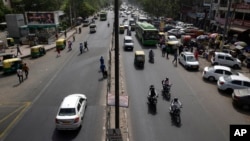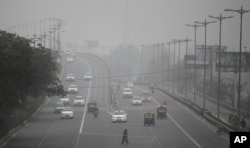Traffic was noticeably thinner on the usually congested roads of the Indian capital, New Delhi, as authorities launched a two week-long plan on Friday to restrict private automobiles on the streets to combat the world’s most toxic air.
It is the second time this year that cars will only be allowed out on alternate days depending on whether the registration plate ends in an odd or even number.
About 5,000 volunteers fanned out in the city to help the traffic police catch violators.
New Delhi Chief Minister Arvind Kejriwal has expressed hopes of making car rationing a permanent feature for two weeks every month. But experts warn that may not be feasible in a city whose notoriously poor public transport is blamed for fueling a massive growth in private vehicles.
Some extra buses were added, particularly on heavy density routes and metro trains are making extra trips, according to officials.
That is unlikely to suffice in a city where many of the 16 million residents rely on eight and a half million vehicles, including cars, motorcycles and auto rickshaws for their daily commute.
New Delhi’s former chief minister, Sheila Dikshit, called on authorities to ensure adequate transportation first, asking, “Half the buses are broken down. How will people travel?”
As during the first experiment in January, there was a long list of those exempted – high ranking officials, politicians, women, and cars carrying school children.
Still, there is much public support for the measure in a city that is becoming aware of the severe damage being caused to its health from toxic vehicular fumes that doctors say get embedded deep inside lungs.
Nandini Guha, who teaches in a local college, said her family members will adjust their schedules to follow the odd-even rule. “It is about time we did something, otherwise we are heading towards a disaster,” she said.
Many others are delighted because they hope to breeze down the roads without encountering the usual traffic snarls.
Minoo Bhargava said her daily 20-kilometer commute between her South Delhi home and the business hub of Gurgaon had been cut by half in January. “Wonderful, wonderful. Otherwise it used to take me an hour and a half plus every evening, but now I am back in 45 minutes, max,” said Bhargava.
The true test of Delhi’s car rationing will come on Monday when office goers return to the streets – many stayed home on Friday, a Hindu religious holiday. Many are expected to manage by sharing rides -- the odd-even plan has fueled the growth of many apps offering car pooling.
Authorities admit the challenges are greater this time because during the first rollout of car rationing, schools had been shut and the weather had been cooler. Most of the city’s buses are not air conditioned and not a favored choice as temperatures hover around 40 degrees Celsius. Some skeptics have also questioned the measure because it had only reduced air pollution marginally in January.
But Anumita Roychowdhury, who leads the air pollution program at New Delhi’s Center of Science and Environment, said rationing cars is the need of the hour. “Emergency action is critical now. We know congestion has got a very strong correlation with rising pollution,” she said.
She pointed out that authorities are also starting to tackle the other major sources that dirty the city's air – road dust, trash burning, construction activity, and diesel generator sets.
“As far as road dust is concerned today, Delhi government has been asked to look at vacuum cleaning to sweeping to good paving of the pavements, street design. For construction activities they have started to clamp down for not adopting good dust control. For trash burning there is already a legal ban,” she said.









